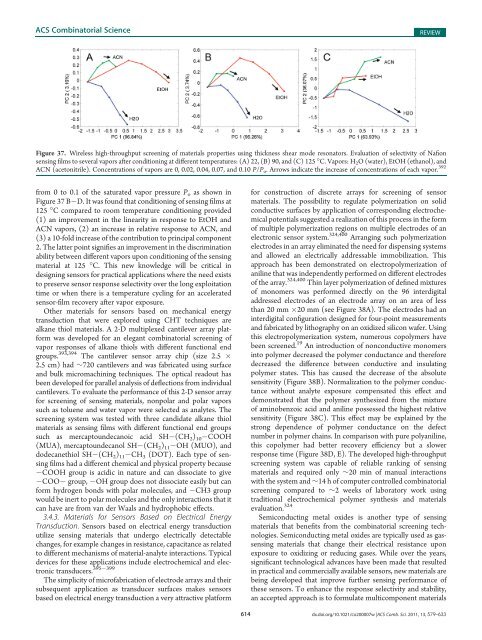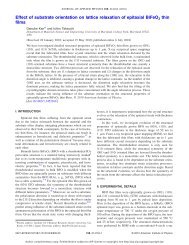Combinatorial and High-Throughput Screening of Materials ...
Combinatorial and High-Throughput Screening of Materials ...
Combinatorial and High-Throughput Screening of Materials ...
Create successful ePaper yourself
Turn your PDF publications into a flip-book with our unique Google optimized e-Paper software.
ACS <strong>Combinatorial</strong> Science<br />
REVIEW<br />
Figure 37. Wireless high-throughput screening <strong>of</strong> materials properties using thickness shear mode resonators. Evaluation <strong>of</strong> selectivity <strong>of</strong> Nafion<br />
sensing films to several vapors after conditioning at different temperatures: (A) 22, (B) 90, <strong>and</strong> (C) 125 °C. Vapors: H 2 O (water), EtOH (ethanol), <strong>and</strong><br />
ACN (acetonitrile). Concentrations <strong>of</strong> vapors are 0, 0.02, 0.04, 0.07, <strong>and</strong> 0.10 P/P o . Arrows indicate the increase <strong>of</strong> concentrations <strong>of</strong> each vapor. 392<br />
from 0 to 0.1 <strong>of</strong> the saturated vapor pressure P o as shown in<br />
Figure 37 B D. It was found that conditioning <strong>of</strong> sensing films at<br />
125 °C compared to room temperature conditioning provided<br />
(1) an improvement in the linearity in response to EtOH <strong>and</strong><br />
ACN vapors, (2) an increase in relative response to ACN, <strong>and</strong><br />
(3) a 10-fold increase <strong>of</strong> the contribution to principal component<br />
2. The latter point signifies an improvement in the discrimination<br />
ability between different vapors upon conditioning <strong>of</strong> the sensing<br />
material at 125 °C. This new knowledge will be critical in<br />
designing sensors for practical applications where the need exists<br />
to preserve sensor response selectivity over the long exploitation<br />
time or when there is a temperature cycling for an accelerated<br />
sensor-film recovery after vapor exposure.<br />
Other materials for sensors based on mechanical energy<br />
transduction that were explored using CHT techniques are<br />
alkane thiol materials. A 2-D multiplexed cantilever array platform<br />
was developed for an elegant combinatorial screening <strong>of</strong><br />
vapor responses <strong>of</strong> alkane thiols with different functional end<br />
groups. 393,394 The cantilever sensor array chip (size 2.5 <br />
2.5 cm) had ∼720 cantilevers <strong>and</strong> was fabricated using surface<br />
<strong>and</strong> bulk micromachining techniques. The optical readout has<br />
been developed for parallel analysis <strong>of</strong> deflections from individual<br />
cantilevers. To evaluate the performance <strong>of</strong> this 2-D sensor array<br />
for screening <strong>of</strong> sensing materials, nonpolar <strong>and</strong> polar vapors<br />
such as toluene <strong>and</strong> water vapor were selected as analytes. The<br />
screening system was tested with three c<strong>and</strong>idate alkane thiol<br />
materials as sensing films with different functional end groups<br />
such as mercaptoundecanoic acid SH (CH 2 ) 10 COOH<br />
(MUA), mercaptoundecanol SH (CH 2 ) 11 OH (MUO), <strong>and</strong><br />
dodecanethiol SH (CH 2 ) 11 CH 3 (DOT). Each type <strong>of</strong> sensing<br />
films had a different chemical <strong>and</strong> physical property because<br />
COOH group is acidic in nature <strong>and</strong> can dissociate to give<br />
COO group, OH group does not dissociate easily but can<br />
form hydrogen bonds with polar molecules, <strong>and</strong> CH3 group<br />
would be inert to polar molecules <strong>and</strong> the only interactions that it<br />
can have are from van der Waals <strong>and</strong> hydrophobic effects.<br />
3.4.3. <strong>Materials</strong> for Sensors Based on Electrical Energy<br />
Transduction. Sensors based on electrical energy transduction<br />
utilize sensing materials that undergo electrically detectable<br />
changes, for example changes in resistance, capacitance as related<br />
to different mechanisms <strong>of</strong> material-analyte interactions. Typical<br />
devices for these applications include electrochemical <strong>and</strong> electronic<br />
transducers.<br />
395 399<br />
The simplicity <strong>of</strong> micr<strong>of</strong>abrication <strong>of</strong> electrode arrays <strong>and</strong> their<br />
subsequent application as transducer surfaces makes sensors<br />
based on electrical energy transduction a very attractive platform<br />
for construction <strong>of</strong> discrete arrays for screening <strong>of</strong> sensor<br />
materials. The possibility to regulate polymerization on solid<br />
conductive surfaces by application <strong>of</strong> corresponding electrochemical<br />
potentials suggested a realization <strong>of</strong> this process in the form<br />
<strong>of</strong> multiple polymerization regions on multiple electrodes <strong>of</strong> an<br />
electronic sensor system. 324,400 Arranging such polymerization<br />
electrodes in an array eliminated the need for dispensing systems<br />
<strong>and</strong> allowed an electrically addressable immobilization. This<br />
approach has been demonstrated on electropolymerization <strong>of</strong><br />
aniline that was independently performed on different electrodes<br />
<strong>of</strong> the array. 324,400 Thin layer polymerization <strong>of</strong> defined mixtures<br />
<strong>of</strong> monomers was performed directly on the 96 interdigital<br />
addressed electrodes <strong>of</strong> an electrode array on an area <strong>of</strong> less<br />
than 20 mm 20 mm (see Figure 38A). The electrodes had an<br />
interdigital configuration designed for four-point measurements<br />
<strong>and</strong> fabricated by lithography on an oxidized silicon wafer. Using<br />
this electropolymerization system, numerous copolymers have<br />
been screened. 19 An introduction <strong>of</strong> nonconductive monomers<br />
into polymer decreased the polymer conductance <strong>and</strong> therefore<br />
decreased the difference between conductive <strong>and</strong> insulating<br />
polymer states. This has caused the decrease <strong>of</strong> the absolute<br />
sensitivity (Figure 38B). Normalization to the polymer conductance<br />
without analyte exposure compensated this effect <strong>and</strong><br />
demonstrated that the polymer synthesized from the mixture<br />
<strong>of</strong> aminobenzoic acid <strong>and</strong> aniline possessed the highest relative<br />
sensitivity (Figure 38C). This effect may be explained by the<br />
strong dependence <strong>of</strong> polymer conductance on the defect<br />
number in polymer chains. In comparison with pure polyaniline,<br />
this copolymer had better recovery efficiency but a slower<br />
response time (Figure 38D, E). The developed high-throughput<br />
screening system was capable <strong>of</strong> reliable ranking <strong>of</strong> sensing<br />
materials <strong>and</strong> required only ∼20 min <strong>of</strong> manual interactions<br />
with the system <strong>and</strong> ∼14 h <strong>of</strong> computer controlled combinatorial<br />
screening compared to ∼2 weeks <strong>of</strong> laboratory work using<br />
traditional electrochemical polymer synthesis <strong>and</strong> materials<br />
evaluation. 324<br />
Semiconducting metal oxides is another type <strong>of</strong> sensing<br />
materials that benefits from the combinatorial screening technologies.<br />
Semiconducting metal oxides are typically used as gassensing<br />
materials that change their electrical resistance upon<br />
exposure to oxidizing or reducing gases. While over the years,<br />
significant technological advances have been made that resulted<br />
in practical <strong>and</strong> commercially available sensors, new materials are<br />
being developed that improve further sensing performance <strong>of</strong><br />
these sensors. To enhance the response selectivity <strong>and</strong> stability,<br />
an accepted approach is to formulate multicomponent materials<br />
614 dx.doi.org/10.1021/co200007w |ACS Comb. Sci. 2011, 13, 579–633












